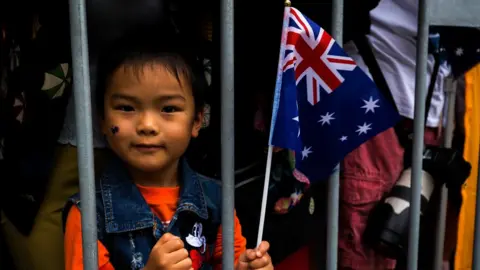Australia census: Five takeaways from a changing country
 Getty Images
Getty ImagesThe results of Australia's 2016 census have been released, and they paint a clear picture of a country in the midst of change.
Here are five takeaways (There will be a quiz at the end!):
1. It's becoming more Asian and less European
Modern Australia has been built on immigration, and the latest census confirms this, finding that almost half (49%) of all Australians were born overseas or had at least one parent born abroad.
But fewer of those arriving in Australia are coming from Europe - once the dominant source of migrants for a country that restricted immigration until the 1970s under the "White Australia" policy.
The 2016 census found that 40% of the overseas-born population were born in Asia, marking the first time more people have come from there than Europe.
In 2001, just 24% of those born overseas came from Asia.
In comparison, the proportion born in Europe decreased from 52% in 2001 to 34% in 2016.
While the number one place of origin for foreign-born migrants is still England, at 15%, migrants from China (8.3%) and India (7.4%) have been arriving in greater numbers in recent years.
In total, migrants born in China, India, the Philippines, Vietnam and Malaysia now outnumber those born in Europe and New Zealand.
2. The largest religious affiliation is no religion
For the first time, more Australians (29.6%) said they had "no religion" than any other specific affiliation, up from 16% in 2001.
This was followed by Catholic (22.6%), Anglican (13.3%), none stated (9.6%), the Uniting Church (3.7%), Muslim (2.6%), Buddhist (2.4%), Hindu (1.9%), Other (0.8%), Sikh (0.5%) and Jewish (0.4%).
3. The indigenous population is growing fast
Some 2.8% of Australians said they were Aboriginal or Torres Strait Islander, up from 2.5% in 2011.
The total number increased by more than 100,000 people, or 18% - from 548,368 in 2011 to 649,171 in 2016.
 Getty Images
Getty ImagesEstimates of the size of the indigenous population before Europeans arrived in Australia in 1788 range from 315,000 to more than one million people. The population sharply declined from that point due to new diseases, violence, displacement and dispossession.
4. Watch out Sydney, Melbourne could soon be the largest city
Australia's best known city could soon be overtaken by Melbourne in terms of its population size.
Melbourne's population is growing faster and has reached 4.4m, not far behind Sydney's 4.8m people.
But with a weekly median rent of A$350 ($265; £200), compared to A$440 for Sydney, it's not difficult to see why more people are being drawn to Melbourne.
5. Fewer people are speaking English at home
A huge number of languages are spoken in Australian homes - more than 300 - including Indigenous languages.
More than one in five Australians (22.2%) speak a language at home that is not English. The most common one is Mandarin (2.5%), followed by Arabic (1.4%) , Cantonese (1.2%), Vietnamese (1.2%) and Italian (1.2%).
Reporting by the BBC's Kevin Ponniah
